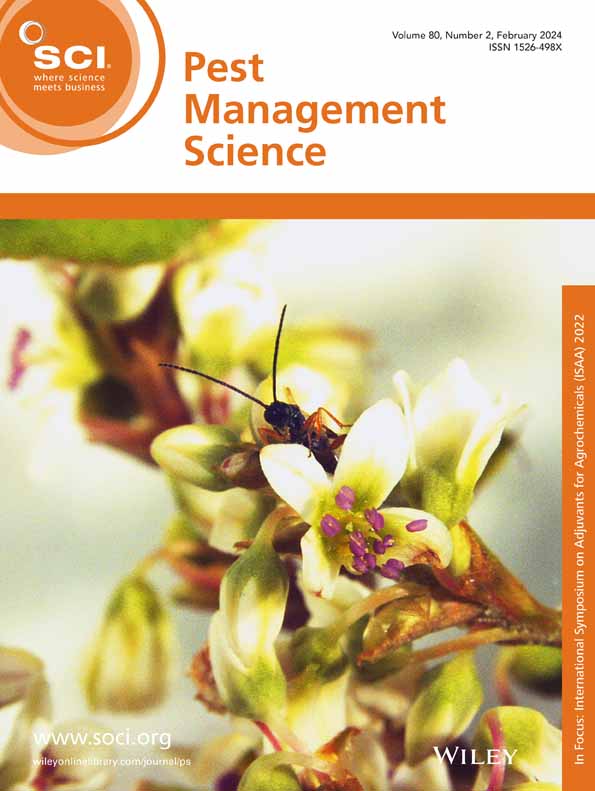Mutating the cysteine residues within the WCCH motif of tobacco curly shoot virus (TbCSV) V2 protein attenuates viral infection and confers cross‐protection against infection by severe strain
IF 3.8
1区 农林科学
Q1 AGRONOMY
Zeyi Xiao, Jinmin Deng, Jiayao Liu, Yuan Yuan, Weiyin Tian, Shengyu Jiang, Qiao Li, Yang Yang, Gentu Wu, Ling Qing, Mingjun Li
求助PDF
{"title":"Mutating the cysteine residues within the WCCH motif of tobacco curly shoot virus (TbCSV) V2 protein attenuates viral infection and confers cross‐protection against infection by severe strain","authors":"Zeyi Xiao, Jinmin Deng, Jiayao Liu, Yuan Yuan, Weiyin Tian, Shengyu Jiang, Qiao Li, Yang Yang, Gentu Wu, Ling Qing, Mingjun Li","doi":"10.1002/ps.8869","DOIUrl":null,"url":null,"abstract":"BACKGROUNDTobacco curly shoot virus (TbCSV, <jats:italic>Begomovirus</jats:italic>, <jats:italic>Geminiviridae</jats:italic>) is a viral agent that poses a serious threat to economically important crops like tomato and tobacco in Southwest China. The geminiviral V2 protein has been demonstrated to play multifunctional roles essential for viral infection and pathogenicity. This study comprehensively investigated the biological importance of five cysteines within the conserved ‘WCCH’ motif of the TbCSV V2 protein, and evaluated the effects of cysteine mutations on viral pathogenicity and the efficacy for cross‐protection against wild‐type severe TbCSV train.RESULTSSite‐directed mutagenesis revealed that among the five cysteines in the V2 protein, C84, C86 and C89 residues are critical for its RNA silencing suppression activity, with C84 being the only residue whose mutation impaired its ability to induce tissue necrosis when expressed by potato virus X (PVX). Mutations at C84, C86 or C89 attenuated viral pathogenicity, and the mild symptoms were accompanied by reduced viral accumulations in <jats:italic>Nicotiana benthamiana</jats:italic> plants. Notably, pre‐inoculation with the attenuated TbCSV mutant C84A in <jats:italic>N. benthamiana</jats:italic> and tomato plants conferred effective cross‐protection against subsequent challenge infection by wild‐type TbCSV.CONCLUSIONThe cysteine residues within the ‘WCCH’ motif of TbCSV V2 protein play distinct roles in its functions and viral pathogenicity. Importantly, the attenuated C84A mutant generated in this study not only offers insights into the pathogenic mechanisms of TbCSV but also holds promise for application in crop protection through cross‐protection strategy in the field. © 2025 Society of Chemical Industry.","PeriodicalId":218,"journal":{"name":"Pest Management Science","volume":"10 1","pages":""},"PeriodicalIF":3.8000,"publicationDate":"2025-05-08","publicationTypes":"Journal Article","fieldsOfStudy":null,"isOpenAccess":false,"openAccessPdf":"","citationCount":"0","resultStr":null,"platform":"Semanticscholar","paperid":null,"PeriodicalName":"Pest Management Science","FirstCategoryId":"97","ListUrlMain":"https://doi.org/10.1002/ps.8869","RegionNum":1,"RegionCategory":"农林科学","ArticlePicture":[],"TitleCN":null,"AbstractTextCN":null,"PMCID":null,"EPubDate":"","PubModel":"","JCR":"Q1","JCRName":"AGRONOMY","Score":null,"Total":0}
引用次数: 0
引用
批量引用
Abstract
BACKGROUNDTobacco curly shoot virus (TbCSV, Begomovirus , Geminiviridae ) is a viral agent that poses a serious threat to economically important crops like tomato and tobacco in Southwest China. The geminiviral V2 protein has been demonstrated to play multifunctional roles essential for viral infection and pathogenicity. This study comprehensively investigated the biological importance of five cysteines within the conserved ‘WCCH’ motif of the TbCSV V2 protein, and evaluated the effects of cysteine mutations on viral pathogenicity and the efficacy for cross‐protection against wild‐type severe TbCSV train.RESULTSSite‐directed mutagenesis revealed that among the five cysteines in the V2 protein, C84, C86 and C89 residues are critical for its RNA silencing suppression activity, with C84 being the only residue whose mutation impaired its ability to induce tissue necrosis when expressed by potato virus X (PVX). Mutations at C84, C86 or C89 attenuated viral pathogenicity, and the mild symptoms were accompanied by reduced viral accumulations in Nicotiana benthamiana plants. Notably, pre‐inoculation with the attenuated TbCSV mutant C84A in N. benthamiana and tomato plants conferred effective cross‐protection against subsequent challenge infection by wild‐type TbCSV.CONCLUSIONThe cysteine residues within the ‘WCCH’ motif of TbCSV V2 protein play distinct roles in its functions and viral pathogenicity. Importantly, the attenuated C84A mutant generated in this study not only offers insights into the pathogenic mechanisms of TbCSV but also holds promise for application in crop protection through cross‐protection strategy in the field. © 2025 Society of Chemical Industry.
烟草卷曲茎病毒(TbCSV) V2蛋白WCCH基序内的半胱氨酸残基突变可减弱病毒感染,并对严重毒株的感染具有交叉保护作用
烟草卷枝病毒(TbCSV, begomvirus, geminivirridae)是一种严重威胁中国西南地区重要经济作物,如番茄和烟草的病毒。双病毒V2蛋白已被证明在病毒感染和致病性中起着重要的多功能作用。本研究全面研究了TbCSV V2蛋白保守的“WCCH”基序中5个半胱氨酸的生物学重要性,并评估了半胱氨酸突变对病毒致病性的影响以及对野生型严重TbCSV菌株的交叉保护效果。结果位点定向诱变结果显示,在V2蛋白的5个半胱氨酸中,C84、C86和C89残基对其RNA沉默抑制活性至关重要,只有C84残基在马铃薯病毒X (PVX)表达时发生突变,导致其诱导组织坏死的能力受损。C84、C86或C89的突变减弱了病毒的致病性,并且在烟叶植物中,轻微的症状伴随着病毒积累的减少。值得注意的是,在拟南芥和番茄植株中预先接种减毒的TbCSV突变体C84A,可以有效地交叉保护植株免受野生型TbCSV的侵染。结论TbCSV V2蛋白WCCH基序内的半胱氨酸残基在其功能和病毒致病性中发挥着重要作用。重要的是,本研究中产生的C84A减毒突变体不仅为TbCSV的致病机制提供了新的见解,而且还有望通过田间交叉保护策略应用于作物保护。©2025化学工业协会。
本文章由计算机程序翻译,如有差异,请以英文原文为准。

 求助内容:
求助内容: 应助结果提醒方式:
应助结果提醒方式:


